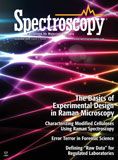Compositional Depth Profiling of Hard Disks with Glow Discharge Atomic Emission Spectrometry (GD-AES)
Spectroscopy
Hard disk manufacturing requires high levels of precision at nanometer scale for the production of a repeatable product with high memory density. Because hard disks are dependent upon magnetic properties to read and write to each memory unit, the disk has a layered structure comprised of magnetic and nonmagnetic materials. Over the last two decades, extensive work has been done by hard disk manufacturers to reduce grain size, which enables smaller, but consistent magnetic domain sizes and distinct boundaries. This movement toward tighter anufacturing tolerances requires advanced techniques for characterization. Compositional depth profiling with GD-AES enables precise characterization of the size of these thin layers of material.
Hard disk manufacturing requires high levels of precision at nanometer scale for the production of a repeatable product with high memory density. Because hard disks are dependent upon magnetic properties to read and write to each memory unit, the disk has a layered structure comprised of magnetic and nonmagnetic materials. Over the last two decades, extensive work has been done by hard disk manufacturers to reduce grain size, which enables smaller, but consistent magnetic domain sizes and distinct boundaries. This movement toward tighter manufacturing tolerances requires advanced techniques for characterization. Compositional depth profiling with GD-AES enables precise characterization of the size of these thin layers of material.
Experimental Conditions
A LECO GDS-850A was used for the analysis of the layers of a hard disk.
Lamp: Grimm-style RF 4-mm Lamp
RF Voltage: 1000 V
True Plasma Power®: 20 W
Pressure: 6.8 to 7.8 Torr of Ar
Analysis Time: 30 s
Results
Several layers are plainly apparent in the compositional depth profile in Figure 1. A lubricating organic layer of carbon and oxygen is followed by a protective carbon and boron layer. A magnetic platinum-cobalt layer is followed by a nonmagnetic ruthenium layer, which stabilizes the magnetic layers.

Figure 1: Five repeated compositional depth profiles of the layered surface of a hard disk (a) obtained with a LECO GDS-850A. Close examination of the first few layers (b) shows the small lubricating and protective layers that are sputtered away in the first few hundred milliseconds of the analyses.
A series of thin layers follow these key regions, such as a magnetic Ni layer, a Zr-Fe-Co-Ta seed layer, and a sublayer of electroless nickel that is adhered to the Al substrate. The precision of the GD-AES technique is shown by the often indistinguishable lines in the depth profile between five iterations. The layers shown were obtained in the first 2 s of the analysis. The earliest layers, shown in the zoomed-in plot in Figure 1, can be repeatedly measured to be less than 3 nm thick.
Without the rapid stabilization capability of the GDS-850A source, the first lubricating carbon layer would be sputtered away before stabilization and would be lost. The constantly changing composition has an undeniable effect on the plasma impedance, and thus the powering and plasma parameters. LECO’s True Plasma Power can appropriately adjust for the fundamental losses known to exist when RF power is used (1). Accordingly, power and voltage (and thus current) are held steady and pressure is rapidly adjusted to maintain steady RF conditions that mimic the conditions of conventional DC analyses (2). Finally, LECO’s depth profiling algorithm, which adjusts for the differences in sputtering rates of different materials, enables the accurate measurement of depth without an added costly accessory.
Conclusion
GD-AES compositional depth profiling was used to measure nanometer-scale layers of a sample surface with a high degree of precision in the span of only a few seconds. This method can be effectively utilized for characterizing the manufacturing tolerances of complex layers at a nm scale.
References
- K.A. Marshall, T.J. Casper, K.R. Brushwyler, and J.C. Mitchell, J. Anal. At. Spectrom.18, 637–645 (2013).
- K.A. Marshall, J. Anal. At. Spectrom.14, 923–928 (1999).
LECO Corporation
3000 Lakeview Avenue, St. Joseph, MI 49085
tel. (269) 985-5496, fax (269) 982-8977
Website: www.leco.com
